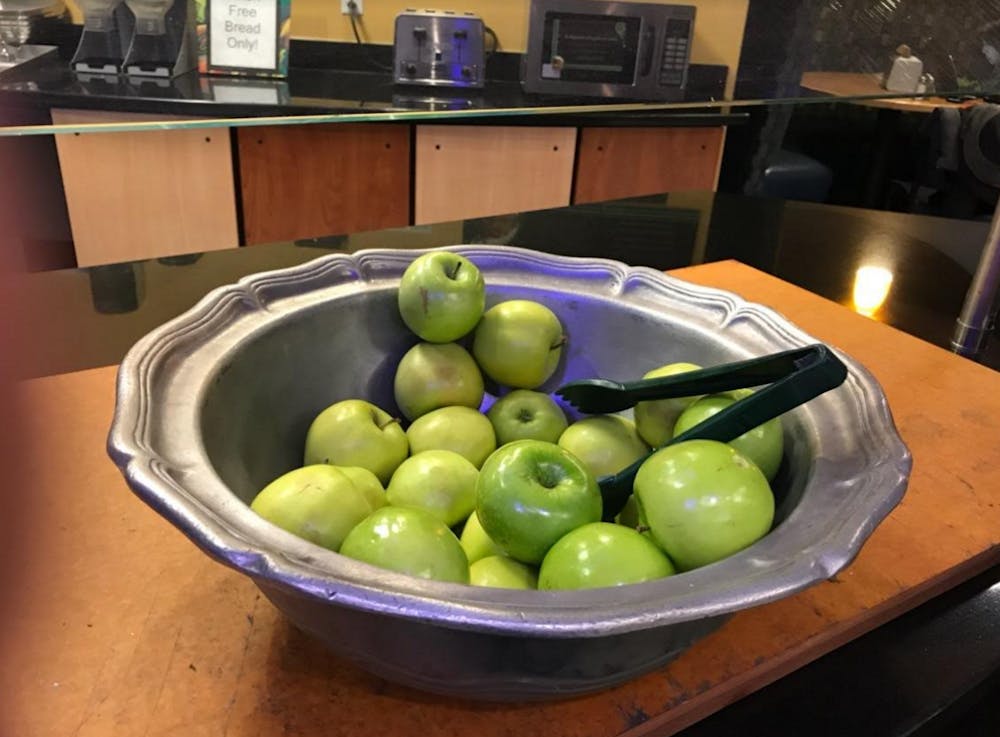By Breeda Bennett-Jones
Nation & World Editor
Despite the plethora of cafés, stands and micro-restaurants on the College’s campus, finding a fresh meal that goes beyond being simply edible is a challenge for some students.
Hundreds of students stream through Eickhoff Hall’s automatic double doors each day, swipe their cards at the counter and set out to find something to eat. After they load up their plates, grab utensils, pour themselves a drink and find a table with their friends, the meal seems complete except for one key component –– fresh fruits and vegetables.
In Eickhoff, the Brower Student Center, the Marketplace C-Store, the Education Building Café and the Library Café, fresh in-season fruits and vegetables are either hard to find, of poor quality or too expensive for penny-pinching college students. While Sodexo, the College’s food supplier, offers mindful, meatless and gluten-free options, the College’s student body suffers from an absence of greens and other fresh sources of vitamins and nutrients.
This conundrum became apparent months ago to Daniela Pareja, a freshman biology and secondary education major.
Pareja stood at the counter of the 31 North Deli in Eickhoff, waiting for an answer that would mean the difference between eating in the dining hall and eating in her dorm room. She had asked if the pineapple behind the glass was fresh.
“I don’t know,” Pareja recalled a worker replying. “We get it from some random company.”
Pareja has an allergy that prevents her from eating fruit with added preservatives.
“Here, you never know when it’s fresh or not,” Pareja said.
Monotonous cuisine is most prominent in Eickhoff, where most students who live on campus eat dinner. Though most of the 10 micro-restaurants serve a steamed vegetable, carbohydrate and source of protein every day, the lack of fresh fruit is still apparent.

There are several bowls of bananas, oranges and apples dotted throughout the hall, displayed on counters between bags of chips, next to the salad bar and at the back of an alcove called My Zone, an area dedicated to gluten-free options. On a typical day, available fruits include honeydew and cantaloupe, which sit in metal tins at the yogurt station.
The fruit bowls rotate daily, according to Patrice Mendes, the College’s Sodexo general manager, who explained the challenges Sodexo faces with the placement of fruits like apples, melon and cantaloupe. According to health code guidelines, fruit with edible skin must be placed behind a sneeze guard, a slab of glass protectant.
“Apples have been available daily, but due to this restriction they are not as visible as the oranges and bananas that we can put out more prominently,” Mendes said.
For most of October last year, the apples were nowhere to be found before they finally returned to their usual corner by My Zone. Their presence remains a gamble, however, and depending on the time of day, the bowls could be empty.
At other dining areas on campus, making healthy choices is even more difficult. At the Education Café, a three-inch-tall plastic container of strawberries is $2.99. With an average of four or five strawberries per container, each strawberry costs approximately 75 cents each.
“Sodexo pricing is based on cost to us from our vendors,” Mendes said. “Items such as strawberries are high cost due to them being out of season in this area … getting a popular item like strawberries out of season increases the price.”
Despite the rarity and high cost of fresh produce, Sodexo representatives emphasize the importance of healthy eating.
“The connection between how eating healthy positively affects both mental and physical performance is becoming more and more clear,” Mendes said. “Offering foods that are good for students’ bodies and brains is a priority for my team and I.”
When asked specifically where the College’s produce come from, Mendes referred to the maps hanging around Eickhoff. According to Mendes, the map lists farms for Kegel’s Produce, one of the College’s two produce distribution vendors. The other is Sysco, a multinational foodservice company with hundreds of locations ranging from Philadelphia to Los Angeles.
“Items that may come through Sysco could be specific to a theme meal or customized menu,” Mendes said. “At times, we do get produce through them as well.”
College students are under immense pressure to excel academically, complete internships and line up post-graduate jobs. The lack of available fruits and vegetables is an additional burden for boarding students who are dependent on Sodexo for all of their meals.
“I don’t hate Eickhoff,” said Seana Cleary, a freshman nursing major. “I feel like there’s always options, even if it doesn’t seem like there are. You can’t hate every single thing that’s in there. For what it is, it could be worse.”
Food quality is also an important component in making a college decision for high school seniors.
Each August, millions of college freshmen across the U.S. transition from home-cooked meals to campus dining.
The $20 billion corporation services schools, jails, hospitals and military bases in more than 80 countries, according to The Investigative Fund.
Some students enjoy Eickhoff’s bustling environment.
“I like Eickhoff because there’s a ton of food, it’s very convenient and I like the atmosphere,” said Cooper Lang, a freshman mechanical engineering major. “I like the people who work there. It’s pretty much the overall experience that makes it for me.”
In New Jersey, Sodexo is on five campuses including William Paterson, Ramapo College and Saint Peter’s University, according to Mendes.
On the College’s campus, students with dietary restrictions are subject to additional setbacks. Despite the addition of an on-staff nutrition manager, Pareja explained, getting food in the dining hall is a struggle that forces her to eat breakfast and lunch in her dorm almost every day.
“The problem is, the nutritionist isn’t with you 24/7 to enforce that,” Pareja said. “Even if I didn’t have the food allergy, it would still be hard to find a variety of healthy food.”
Students with allergies and meal restrictions including vegetarianism and veganism have also been frustrated with campus dining.
“I think for vegetarian options, a lot of places on campus are lacking,” said Meghan Feeley, a freshman art education major.
The quality of food available to students has the potential to put a damper on campus life, especially for students with dietary restrictions. However, despite its shortcomings, on-campus dining options appeal to those looking for a filling meal with daily variety.







